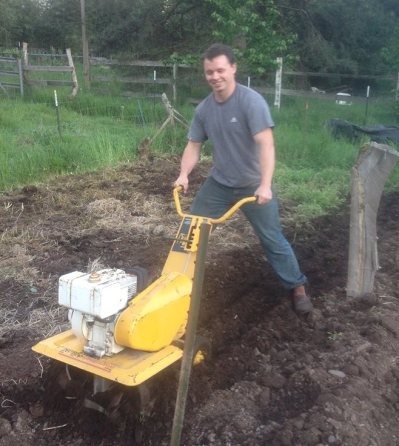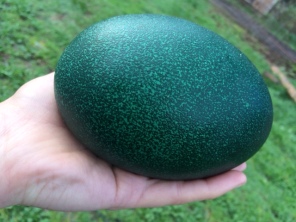It’s not the technology, but the feeling in the heart of the (hu)man, that really counts.

Nagdeo Farm went industrial this spring! (Well, in 2 of our 16’x16′ garden blocks – the rest of the soil on our 10 acres went largely undisturbed by farm machinery). The past couple years we’ve done all our soil prep and bed prep in the garden by hand and animal, but this year we found a cute old rototiller at a garage sale that we couldn’t resist. Our neighbor fixed it up for trade, and here’s Mikey on the test run in our potato plot.
We’ve been reading Mutant Message Down Under with two of our interns, Sarah and Blue. Our saying above was derived from this passage:
“…How you feel emotionally about things is what really registers. It is recorded in every cell of the body, in the core of your personality, in your mind, and in your eternal self...Giving water to a dying plant or animal, or giving encouragement, gains as much enlightenment for knowing life and our Creator as finding a thirsty person and providing nourishment.”
We would add that giving water to a dying person with resentment or animosity in your heart is not a gift at all and can even be an act of taking emotional energy from the other person. We try (with plenty of mistakes) to apply this to everything we do.
In general, we prefer to do things by hand in the garden, working together. Sometimes we also use modern technology. But whether we’re using a bone digging stick or a rototiller, we try to make sure we are grateful, centered, and joyful when we do anything. If we are too tired, grumpy, or otherwise off, we try to simply breathe and address our feelings until we can interact in the world with love to give.
————————–
This year’s spring surprise: Emu Egg!


No, it’s not painted. And yes, one egg took up the entire pan. Our emu, Charlie, is over 20 years old and supposedly infertile. But miraculously this February she popped out this huge blue-green egg! It was the fluffiest fried egg you ever tasted. We saved the shell.
———————
Transitions
One of our long-term residents is moving away. Sheefra headed back to the southeastern US to seek out new adventures and reconnect with old friends. The move seems to be in alignment for everyone, but it is sad to see one of our main residents go. Below are some wonderful moments we shared before she left: a rare rainbow we stopped to witness together; digging potato rows (bottom left); and singing while we planted the viburnum opulus, or cramp bark, tree that she left in our care (bottom right, with mugwort in the foreground and strawberries in the background) . We’re still in touch with her by phone and email and will always remember the sweet moments we shared with her here at the farm. Check out her blog: http://www.secretsofthedoe.wordpress.com.



————————–
Snapshots of Spring
Here are a few photos from around the farm this spring…
Below: baby beets (left) and a young burdock with dandelion seed resting on it (right).
Below: Stinging Nettle (urtica dioica), AKA Nature’s Multivitamin.

We ate a lot of nettles this spring (usually boiled briefly like broccoli), starting in January. They are soooo yummy and nutritious! High in calcium, iron, and vitamin A, with many other vital nutrients and minerals and even a little protein. Overall, excellent for fortifying the blood and liver, assisting the kidneys (diuretic – make sure you drink plenty of water if you’re eating them) and a great aid to detoxification. This herb can help clear up your skin, bolster your energy, and bring you joy with its magic and beauty! A major help in spring fasting and a great addition to a normal diet, with the added benefit that regular consumption of it throughout the pollen season can prevent the emergence of allergies. Normally we harvest extra and dry them for use through the rest of the seasons, but this year we just ate them fresh.
Right now most of them hover at shoulder level and are flowering (not so good to eat but still makes great tea!). More about this plant in fall, when we harvest the dry stalks for making string!
Below: juvenile storage onions (left) and rapidly growing mixed brassicas (right).


Brassica family plants include kale, broccoli, cauliflower, cabbage, brussels sprouts, and kohlrabi and are all highly nutritious and tasty (great source of vitamin C and other important nutrients). Onions and garlic are in the allium family of plants, most of them with the classic pungent smell and excellent medicinal qualities (immune-boosting and anti-parasitic among other qualities). Although we didn’t plant them next to each other this year, these two pair well in the garden – alliums deter many of the insects that commonly eat brassicas and they have similar soil needs.
Below: JD with our new dog, Scout.


He’s an older dog, mellow but still active, very good-natured and overall a great fit for us. We weren’t really looking for a dog but he came up free on craigslist and we decided to give him a try. He seems to fit in great!
—————————-
Well, that’s all for now. We’ll check in again with late summer.
Nagdeo!

